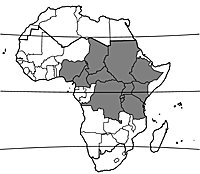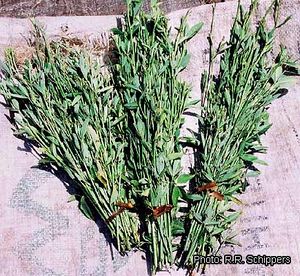Crotalaria brevidens (PROTA)
Introduction |
Crotalaria brevidens Benth.
- Protologue: London Journ. Bot. 2: 585 (1843).
- Family: Papilionaceae (Leguminosae - Papilionoideae, Fabaceae)
- Chromosome number: 2n = 16
Synonyms
- Crotalaria intermedia Kotschy (1865).
Vernacular names
- Slenderleaf, rattlepod, rattle pea, Ethiopian rattlebox (En).
- Crotalaire, sonnette (Fr).
- Marejea (Sw).
Origin and geographic distribution
Crotalaria brevidens occurs in the wild from northern Nigeria eastwards to Ethiopia and south to southern Tanzania. It has been introduced into the Americas. It is reported as cultivated and eaten as a vegetable in Sudan, Kenya, Uganda and Tanzania.
Uses
Slenderleaf is grown for its young leaves and shoots, and is used as a cooked vegetable. In Kenya and Tanzania it is known as ‘marejea’ or ‘mitoo’, in Uganda as ‘alaju’. Elderly people appreciate its bitterness, whereas younger people prefer the closely related rattlepod Crotalaria ochroleuca G.Don. Slenderleaf is consumed boiled or fried in oil and is also used as a potherb in stews or soups. It is often boiled together with Jew’s mallow (Corchorus olitorius L.) to reduce the bitter taste; tomatoes, onions, oil and/or milk are added.
A number of medicinal applications have been reported. In Kenya the leaves are used to cure stomach-ache, swellings and malaria. The roots are used to treat sore throat and mouth thrush. The shoots are used as livestock fodder and seeds are fed to poultry. Slenderleaf is also used as a green manure as its roots nodulate profusely and fix nitrogen. It is occasionally used for its fibre. A recent use for slenderleaf is as an agent to promote the germination of Striga, a parasitic plant that is a major problem for maize and millet growers. In the presence of Crotalaria, Striga germinates and it will subsequently die due to the lack of a suitable host plant. Crotalaria is also known to suppress Meloidogyne nematode populations.
Production and international trade
Crotalaria brevidens is a vegetable of small-scale production. Since it is generally grouped together with statistics on other green vegetables, no individual data are available.
Properties
The composition of leaves of Crotalaria brevidens and the related Crotalaria ochroleuca per 100 g fresh edible portion is: water 74.5 g, protein 8.8 g, Ca 222 mg, Fe 0.8 mg (Leung, W.-T.W., Busson, F. & Jardin, C., 1968). The composition is comparable to other dark green leaf vegetables, except that the dry matter content is higher than average. The leaves are very bitter due to the presence of toxins such as pyrrolizidine alkaloids, diterpenes and phenolic compounds.
Adulterations and substitutes
In dishes slenderleaf can be replaced by Crotalaria ochroleuca or other Crotalaria species.
Description
- Erect much-branched annual or short-lived perennial herb up to 2 m tall; branches usually ascending, with short appressed to slightly spreading hairs.
- Leaves alternate, 3-foliolate; stipules absent; petiole 2–6 cm long; leaflets linear to lanceolate or elliptical, 4–10(–14) cm × 0.3–2(–3.3) cm, appressed puberulous below.
- Inflorescence a terminal raceme up to 50 cm long, many-flowered; bracts linear to subulate, 1–3.5 mm long.
- Flowers bisexual, zygomorphic, 5-merous; calyx 3–8 mm long, becoming truncate at base, deflexed against the pedicel, hairy to glabrous, lobes shorter to slightly longer than tube; corolla yellow, with ovate or elliptical standard veined reddish brown, wings about as long as keel, keel with a long beak, up to 2.5 cm long; stamens 10, all joined in a sheath open at base; ovary superior, 1-celled, style curved, stigma small.
- Fruit a narrowly cylindrical pod 3.5–5 cm × 0.5–1 cm, often slightly curved at the ends, pubescent, black when dry, many-seeded.
- Seeds oblique-cordiform, up to 3 mm long, smooth, pale yellow, turning orange to dark red.
Other botanical information
Crotalaria comprises about 600 species and occurs throughout the tropics. Africa is by far richest with approximately 500 species. Besides the cultivated Crotalaria brevidens, Crotalaria ochroleuca and Crotalaria natalitia Meisn., several wild Crotalaria species are occasionally collected as potherbs, e.g. Crotalaria anthyllopsis Welw. ex Baker, Crotalaria cephalotes Steud. ex A.Rich., Crotalaria cleomifolia Welw. ex Baker, Crotalaria florida Welw. ex Baker and Crotalaria senegalensis (Pers.) Bacle ex DC.
Crotalaria brevidens is closely related to Crotalaria ochroleuca and information cannot always be attributed to either one of them with certainty. Crotalaria brevidens can best be distinguished by the colour of the flower (usually bright yellow vs. pale yellow or creamish in Crotalaria ochroleuca), the calyx (often puberulous vs. glabrous), and the fruit diameter (0.5–1 cm vs. (1–)1.5–2 cm).
Four varieties of Crotalaria brevidens have been distinguished. Var. brevidens, with glabrous calyx 3.5–5(–7) mm long, occurs predominantly in the northern part of the range. Var. intermedia (Kotschy) Polhill, with puberulous calyx 5–8 mm long, is the most widespread. Var. parviflora (Baker f.) Polhill, with a smaller flower, is restricted to the Kenya highlands, whereas var. dorumaensis (R.Wilczek) Polhill is of doubtful status and only known from DR Congo.
Growth and development
The seed germinates in 3–4 days. Initially the plant grows slowly and is ready for harvesting 8 weeks after sowing. Harvesting may continue for 4 months.
Ecology
Slenderleaf occurs in open and wooded grassland and is occasionally found in seasonal swamps and on termitaries, at 500–2700 m altitude.
Propagation and planting
The 1000-seed weight is about 5 g. Slenderleaf is sown broadcast or in rows of 30 cm apart and then thinned 6 weeks after sowing to a spacing of 15–20 cm × 15–20 cm.
Management
Slenderleaf responds well to farmyard manure but less well to artificial fertilizers. Application of 20 t/ha of cattle manure is recommended.
Diseases and pests
Crotalaria brevidens does not suffer much from diseases and even less from pests. Under wet conditions the whole crop may be destroyed by a blight just before it starts flowering. Aphids and thrips can be observed, but are rarely a serious menace. During fruit development, pod borers may enter and interfere with seed development. The holes in the pods will allow rain to enter and destroy the seeds further through rot.
Harvesting
Slenderleaf is uprooted just before flowering when the stems are about 40 cm tall and 8 weeks old. Alternatively, farmers use the thinnings as a first harvest after about 6 weeks and use a ratoon system from there onwards. The ratoon system involves first plucking the main shoot at the 8-week stage and subsequent harvesting of the new side shoots. The main shoot is cut 10–15 cm above the ground, with at least 3 leaves left. New side shoots can be picked again after 2 weeks and harvesting can take place up to 15 times if there is enough rain and application of nitrogen.
Yield
The yield for a once-over harvest is about 10 t/ha (1 kg/m2); for repeated harvests the yield is much higher.
Handling after harvest
Fresh leaves and young shoots are very perishable and do not keep well. At 20–30°C they will last for 1 day; for longer storage they should be kept below 20°C. To reduce deterioration the shoots are tied in bundles, which are regularly sprinkled with water. The leaves are often dried to be sold during the dry season. Drying in the sun takes 3–4 days during the dry season and 6–7 days during the rainy season.
Genetic resources
Crotalaria brevidens is not endangered because it is widely distributed in the wild and several local types are cultivated. It has been included in the Traditional African Vegetables Mandate List for conservation in the SADC region. The Kew Millennium Seed Bank Project has targeted traditional vegetables and established sizeable collections that are kept in both Nairobi and the United Kingdom.
Prospects
Slenderleaf is a popular traditional vegetable in some parts of East Africa, with good nutritional properties. Research priorities are breeding and cultivation technology.
Major references
- Chweya, J.A., 1985. Identification and nutritional importance of indigenous green leaf vegetables in Kenya. Acta Horticulturae 153: 99–108.
- Chweya, J.A., 1997. Genetic enhancement of indigenous vegetables in Kenya. In: Guarino, L. (Editor). Traditional African vegetables. Proceedings of the IPGRI international workshop on genetic resources of traditional vegetables in Africa: conservation and use, 29–31 August 1995, ICRAF, Nairobi, Kenya. Promoting the conservation and use of underutilized and neglected crops 16. pp. 86–95.
- Gillett, J.B., Polhill, R.M., Verdcourt, B., Schubert, B.G., Milne-Redhead, E., & Brummitt, R.K., 1971. Leguminosae (Parts 3–4), subfamily Papilionoideae (1–2). In: Milne-Redhead, E. & Polhill, R.M. (Editors). Flora of Tropical East Africa. Crown Agents for Oversea Governments and Administrations, London, United Kingdom. 1108 pp.
- Maundu, P.M., Ngugi, G.W. & Kabuye, C.H.S., 1999. Traditional food plants of Kenya. Kenya Resource Centre for Indigenous Knowledge (KENRIK), Nairobi, Kenya. 270 pp.
- Olembo, N.K., Fedha, S.S. & Ngaira, E.S., 1995. Medicinal and agricultural plants of Ikolomani Division, Kakamega district, Kenya. Development Partners, Kakamega, Kenya. 107 pp.
- Polhill, R.M., 1982. Crotalaria in Africa and Madagascar. A.A. Balkema, Rotterdam, Netherlands. 389 pp.
- Schippers, R.R., 2000. African indigenous vegetables. An overview of the cultivated species. Natural Resources Institute/ACP-EU Technical Centre for Agricultural and Rural Cooperation, Chatham, United Kingdom. 214 pp.
- Sosef, M.S.M. & van der Maesen, L.J.G., 1997. Minor auxiliary plants. In: Faridah Hanum, I. & van der Maesen, L.J.G. (Editors). Plant Resources of South-East Asia No 11. Auxiliary plants. Backhuys Publishers, Leiden, Netherlands. pp. 264–307.
- Uiso, F.C. & Johns, T., 1996. Consumption patterns and nutritional contribution of Crotalaria brevidens in Tarime District, Tanzania. Ecology of Food and Nutrition 35: 59–69.
- Uiso, F.C. & Johns, T., 1996. Risk assessment of the consumption of a pyrrolizidine alkaloid containing indigenous vegetable, Crotalaria brevidens. Ecology of Food and Nutrition 35(2): 111–119.
Other references
- Cotias de Oliveira, A.L.P. & de Aguiar Perecin, M.L.R., 1999. Karyotype evolution in the genus Crotalaria (Leguminosae). Cytologia 64: 165–174.
- Imbamba, S.K. & Tieszen, L.L., 1977. Influence of light and temperature on photosynthesis and transpiration in some C3 and C4 vegetable plants from Kenya. Physiologia Plantarum 39: 311–316.
- Leung, W.-T.W., Busson, F. & Jardin, C., 1968. Food composition table for use in Africa. FAO, Rome, Italy. 306 pp.
Author(s)
- M.O. Abukutsa-Onyango, Department of Horticulture, Maseno University, P.O. Private Bag, Maseno, Kenya
Correct citation of this article
Abukutsa-Onyango, M.O., 2004. Crotalaria brevidens Benth. [Internet] Record from PROTA4U. Grubben, G.J.H. & Denton, O.A. (Editors). PROTA (Plant Resources of Tropical Africa / Ressources végétales de l’Afrique tropicale), Wageningen, Netherlands.
Accessed 18 December 2024.


